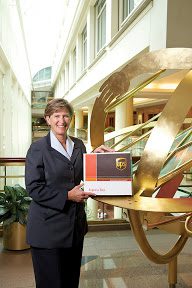Global package delivery company UPS has three goals: create value for customers, transform to strengthen the company’s leadership position and invest in key markets to develop new business. The company’s learning vision is to provide and champion valuable development services to drive these business results.
However, as one of the world’s largest private-sector employers, UPS has less than 20 percent of its employees working from a traditional office — a percentage that likely will not soon change.
“As we look to the future and recognize the global distribution of our audience and dynamic influences that adjust our business every day, our ability to effectively implement learning strategy becomes even more important,” said Mary Kay Kopp, UPS’ global learning network director.
Based on research, market trends and analytics, the company has created two distinct yet dependent strategies. One strategy involves transforming the company’s corporate learning and development function into a leadership development organization. The other, the Global Learning Network strategy, aims to provide leadership and direction in training and talent development.
The execution of these strategies offers greater consistency and enhanced targeted development for UPS employees. It also has resulted in better use of company resources.
For example, to execute the company’s mission to create value for customers, UPS’ leadership and talent development team received a $1.8 million grant from the U.S. Department of Labor to create a training program for the on-road supervisors who manage drivers, called UPS Integrad: Managing Performance.
“We realized we needed to make an adjustment when our younger drivers began requiring significantly more time to become proficient, and more of them were leaving the company during their initial training period,” Kopp said.
Trainees now spend one week at UPS Integrad, an 11,500-square-foot UPS training center just outside of Washington, D.C. There, employees move from one station to another practicing the company’s “340 Methods” prescribed by UPS industrial engineers to save seconds and improve safety in every task — from lifting and loading boxes to selecting a package from a shelf in the truck.
Trainees also play a video game that places them in the driver’s seat and tests their ability to identify and avoid obstacles in real-time. They then progress from computer simulations to “Clarksville,” a village of miniature houses and businesses on the Integrad property. Trainees drive a real truck and must successfully execute five deliveries in less than 20 minutes.
In 2012, the UPS Integrad program reduced the costs associated with driver injury by 56 percent, reduced package delivery costs 12 percent and mileage/time efficiency costs by 7 percent. The company accounted an overall return on investment of 9.2 percent.
“The learning industry is moving at a pace and doing a lot of good things,” said Anne Schwartz, vice president of leadership and development at UPS. “Young people are taking over [baby] boomers’ positions. It’s really important for learning leaders to stay attuned to those things and pull in programs that allow the efficient execution of learning. Everything has to be tied to output. You have to make sure you’re moving the business with learning.”
Moving the business is why the company invests so much time in employee development: UPS invests an average 12.6 hours for each non-management employee per year and 28.3 hours for each management employee. UPS also develops employees based on its legacy of promoting from within.
“We believe the people we bring on, who learn the business and run the business, understand more about the business than people we could hire fresh off the streets to replace them,” Schwartz said. “Investing in our employees is a hallmark of our business, and we invest in employees with learning opportunities to reflect that.”
Kopp and Schwartz said the large number of promotions at UPS indicate its development programs are successful. Roughly 60 percent of the firm’s full-time drivers were once part-time. Further, nearly 80 percent of full-time managers — including most vice presidents — once held non-management positions.















